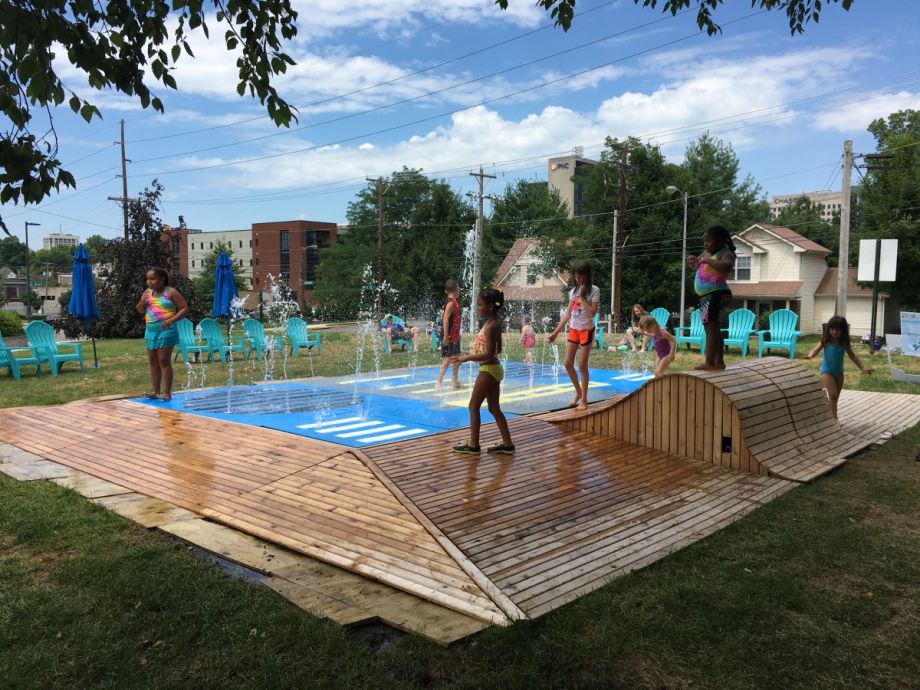This summer was the third hottest on record in Louisville, Kentucky, home to 30 spraygrounds and splash pads that helped residents escape the heat. Seventy-five miles east in Lexington, it was the sixth hottest summer on record, but until July, residents who couldn’t afford the admission fee for public pools had only a fountain for a refreshing respite.
Families with children — and sometimes dogs — flocked to the shallow basin in downtown Thoroughbred Park, splashing and swimming despite a prominent sign warning that the fountain’s recirculated water made it unsafe to enter. In July, when Lexington unveiled its first sprayground directly across the street, the fountain largely emptied out, and five previously disconnected neighborhoods had a new space to bring them together.
That Lexington needed more accessible water play had been evident for some time. People had been ignoring the signage at Thoroughbred Park for years, says Lisa Adkins, president and CEO of the philanthropic Blue Grass Community Foundation. Staff from the park and the Gehl Institute talked to families to find out why. (The Institute is a spin-off of Gehl Architects, and launched in May 2015 with support from the Knight Foundation to work on public space projects in the U.S. and abroad.)
“While the public pools are actually relatively affordable at $5 a head, if you have four or five kids, that’s maybe not a choice you can make,” says Adkins. “And that’s in fact what people were saying. They [used the fountain] as an alternative to the public pool. This was disturbing for a number of reasons, but primarily the equity of it all. We can do better.”
BGCF worked with the Lexington Downtown Development Authority (DDA) and Gehl to come up with a better option. Initially the Gehl Institute wanted to take on Thoroughbred Park itself. It’s touted as the “gateway to the city,” but while undertaking a survey on public space and public life in Lexington, Gehl observed that few people lingered there for long, except to swim illegally and to photograph the park’s namesake bronze horse statues.
Directly across the street, however, was an underused parcel whose transformation was more politically expedient: Northeastern Park, which, despite its playground, went largely underutilized. Because the 20,000-square-foot green space slopes several feet up from the sidewalk, it was strangely invisible from the street. “Even though it’s marked as a city park, you just never saw anybody in this park,” says Adkins. “People would have driven by that sign for years and just the way the park is situated and the land falls, you don’t even know there’s a park up on that land that’s elevated from the sidewalk.”
And it wasn’t just the proximity to Thoroughbred Park that made Northeastern a natural fit for a new sprayground. The park also happens to sit at the intersection of five racially and economically diverse neighborhoods lacking in a shared public space. “We were convinced that if you had the right amenity and the right invitation that we really could create a spot where you could create true engagement with diverse neighbors, and create a really unique community engagement spot that was really nothing like what we have in Lexington,” says Adkins.
Over the course of six months, from January to July, the DDA, BGCF, and designers from Gehl Studio designed and installed SplashJam, a temporary splash pad that sits on the grass at Northeastern Park, fed by a standard garden hose. It’s designed to look like a boom box, complete with integrated Bluetooth speakers that allow visitors to play their own music. Ethan Howard of the DDA says the design was intended to invoke a beachy vibe.
A report measuring the project’s success is underway, but early surveys, observations and pedestrian counts have recorded a high level of engagement. Even before the splash pad opened, children volunteered to blanket the neighborhood with fliers. According to Howard, 83 percent of visitors surveyed thus far said they had rarely or never been to Northeastern Park before the splash pad was installed; 89 percent of those said they’d come back on a regular basis.
Older residents gathered in the shade, rearranging the Adirondack chairs that were installed around the sprayground. Residents showed up with coolers of water and popsicles, with sunscreen to give out. “They might not even be there to run through water, but just to use it because it had become an active space,” says Howard.
This intergenerational, interneighborhood play was particularly striking given that “our downtown does not have a lot of public spaces that are utilized by a cross-section of the public,” says Jeff Fugate of the DDA. “The level of neighborhood ownership [at Northeastern] was striking to me.” Lexington has suburban parks, and a small number of urban ones, “but what we do have downtown are products of the ’80s, almost exclusively, when landscape architecture was much more, how should we say, it was more about the holding and less about the using,” says Fugate.
SplashJam has turned Northeastern into a park for activity, and Gehl’s Public Space Public Life plan calls for further amenities, like a food kiosk and ice skating rink. A new crosswalk has increased pedestrian safety in reaching the park, but the splash pad is still temporary and will be deinstalled in the fall. Adkins, Howard and Fugate hope that the feedback on use will lead to a permanent installation. An aquatics master plan released by the city this winter calls for six new spraygrounds to be installed in Lexington, one of them in an unspecified site downtown. SplashJam’s stakeholders hope to make the case for Northeastern Park.
Jen Kinney is a freelance writer and documentary photographer. Her work has also appeared in Philadelphia Magazine, High Country News online, and the Anchorage Press. She is currently a student of radio production at the Salt Institute of Documentary Studies. See her work at jakinney.com.
Follow Jen .(JavaScript must be enabled to view this email address)
















